Leaving the comfort and the cold of Madaba we headed towards Wadi Rum. We were super excited because we were doing a road trip after a very long time and the idea of spending a night deep inside the mountainous desert under the stars was beyond thrilling!
If earth ever had a gateway to another planet, Wadi Rum would be it. Wadi Rum is a world in itself -far away from the mundane life of its surroundings -beating each and every other tourist destination. A trip to Jordan is never complete without staying at least one night in Wadi Rum.
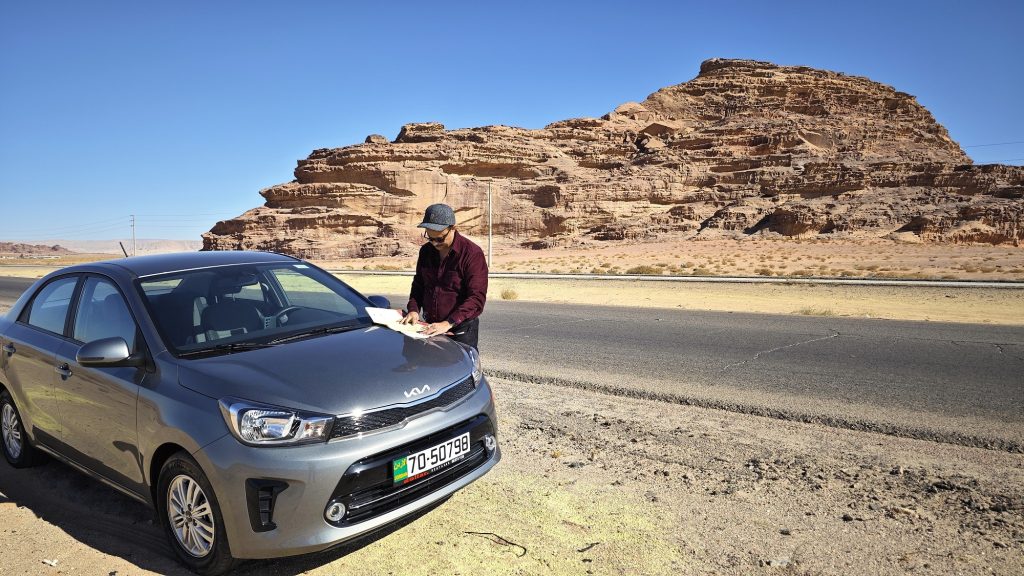
How to reach Wadi Rum
To get from Madaba to Wadi Rum, the most common and efficient route follows a combination of Highway 15 (Desert Highway) and local roads toward Wadi Rum village. Take Highway 35 (King’s Highway) south briefly. Merge onto Highway 15 (Desert Highway) — this is the main highway running north to south through Jordan.
Drive south for about 300 km (approx. 3.5 to 4 hours) toward Ras al-Naqab (past Ma’an and Shobak). Turn left at the Wadi Rum turn-off near the village of Diseh or Ramm (look for signs saying ‘Wadi Rum Protected Area‘ or ‘Wadi Rum Visitor Centre‘). Continue on the Wadi Rum Road (a paved local road) for about 25 km until you reach the Visitor Centre and the entrance to the protected area. The total drive time is around 4 to 5 hours, depending on stops. Fuel up before you enter Wadi Rum — no gas stations inside the protected area. Use Google Maps or an offline GPS app; signage is generally good but sparse in the final stretch.
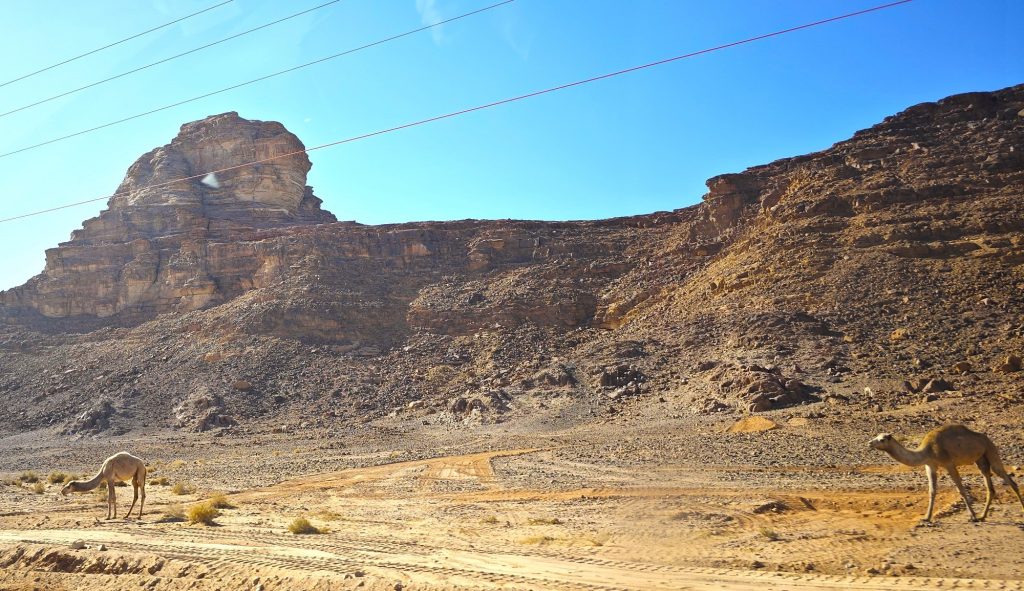
After what felt like a long drive from Madaba, towering rock formations began to rise in the horizon. As we approached Wadi Rum, the landscape transformed dramatically — we began to see a stunning range of sandstone and granite mountains rising sharply from the flat desert floor — a sure sign that Wadi Rum was drawing near. We stopped in front of one such formation to enjoy the view.
We had to reach the Wadi Rum Visitor Centre by 3 pm where our camp manager cum tour guide would come to pick us up and take us to his camp deep inside the Wadi Rum Protected Area . But before that there was one activity which was quite intriguing- a must do for anyone who visits Wadi Rum.
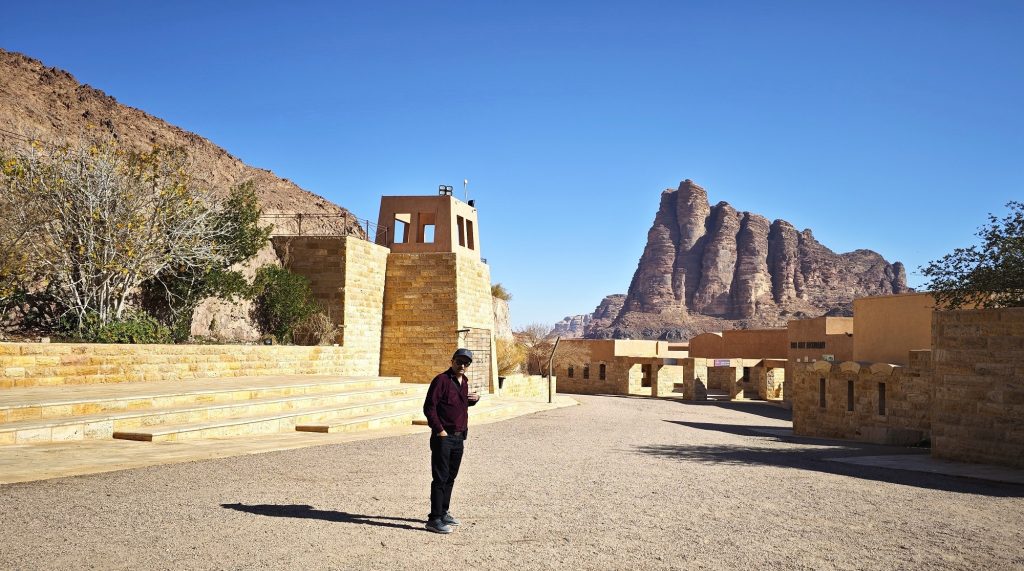
The Hejaz Railway Experience
This was the Hejaz Railway Experience.
The Hejaz Railway once a crucial Ottoman supply and communication route, played a key role during the Great Arab Revolt of 1916 [ You’ll get a detailed explanation on the Arab Revolt in my writeup on Aqaba]. Prince Faisal’s Arab forces launched daring sabotage missions to disrupt this vital line. Today, those moments are vividly brought to life through semi-weekly re-enactments on a vintage steam locomotive (typically on Sundays and Wednesdays), masterfully organized by the Jordan Heritage Revival Company.
After checking in at the Wadi Rum Visitor Centre and having our Jordan Passes stamped , and having lunch, we had to take a detour back to an area just outside the Wadi Rum Visitor’s Centre, where the vintage train waited for passengers to board and have an unforgettable experience.

We boarded the ancient train and found a seat in front of a rifle strategically positioned with a soldier taking care of it. As the old steam locomotive began to chug through the desert with the giant Wadi Rum mountains on both sides, we and the rest of the passengers found ourselves surrounded by more actors dressed as Ottoman soldiers, complete with vintage uniforms and rifles.
On the open deck of the train, with only sacks of sand ,I guess , to protect us from the gunfire, the atmosphere was tense yet thrilling, as everyone aboard kept a lookout toward the hills—waiting for the inevitable ambush by Arab rebels.
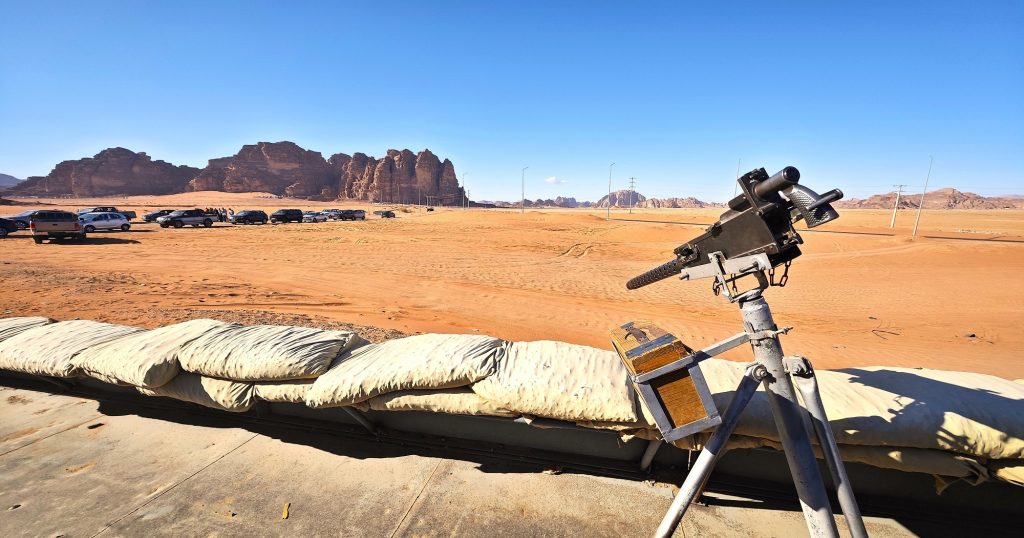
Soon at various intervals we saw the rebels galloping towards us ululating their war cries ,firing at the locomotive. The Ottoman soldiers on the train were not far behind in their valour ,trying to protect us from this dangerous encounter!
The sound of explosions and dramatic confrontations recreated the adrenaline and urgency of wartime in the desert. It reminded me so much of the movie Lawrence of Arabia as well as our very own iconic Sholay. This hour-long theatrical journey was an unforgettable way to connect with Jordan’s rich and rebellious past.
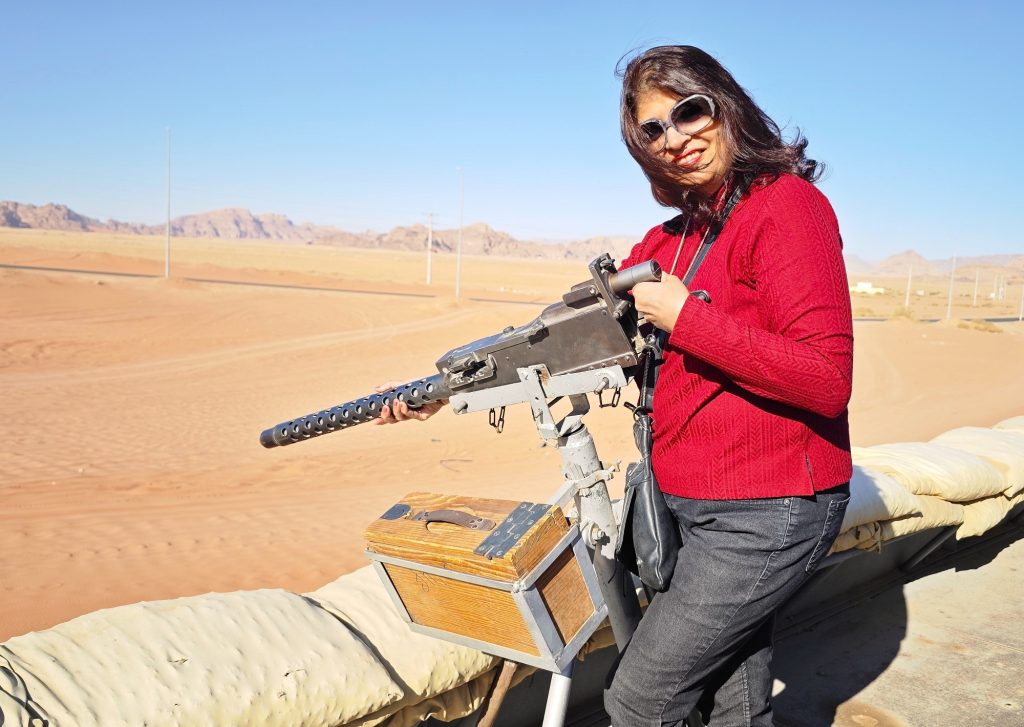
After this fun-filled activity, we headed towards the Wadi Rum Visitor Centre where our Bedouin host was waiting for us. Following our host from the Visitor’s Centre in our car we soon reached Wadi Rum Village ,the entrance to the Wadi Rum Protected Area. Here we had to leave our car and change to our tour operator’s jeep to go deep into the desert. Wadi Rum Village was in the true sense a village. Not to get confused the Visitor’s Centre and the Rum Village are two separated areas ,though to reach the Village you have to pass through the Centre.
Wadi Rum Visitor’s Centre
The Wadi Rum Visitor Centre, located 7 km before Wadi Rum Village, is the main entry point to the Wadi Rum Protected Area. It offers ticketing (free with the Jordan Pass), info on local geology and Bedouin culture, and has a small museum, café, and souvenir shop. From the viewpoints, you can admire the iconic Seven Pillars of Wisdom—we took some great photos of them right after lunch there.
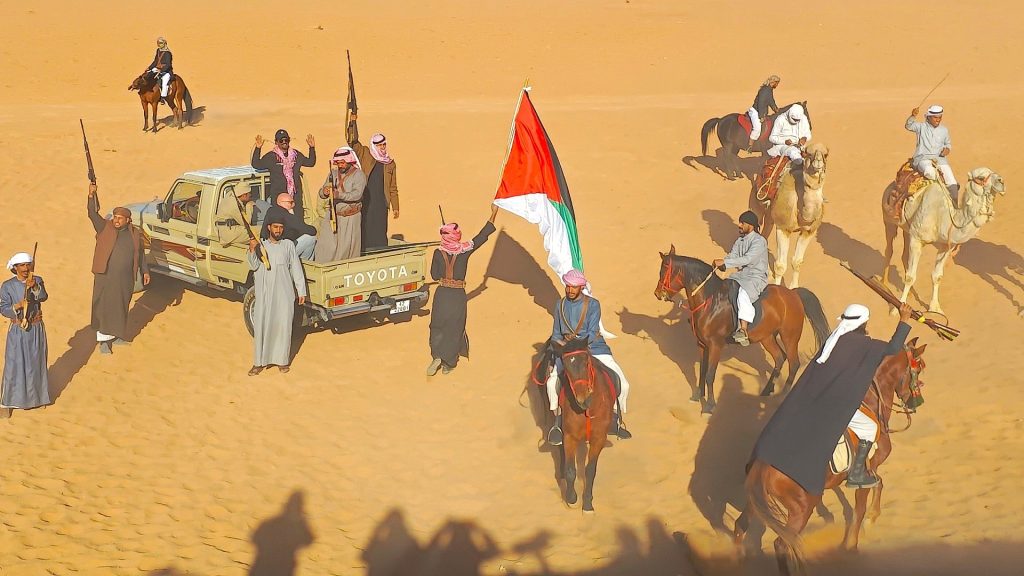
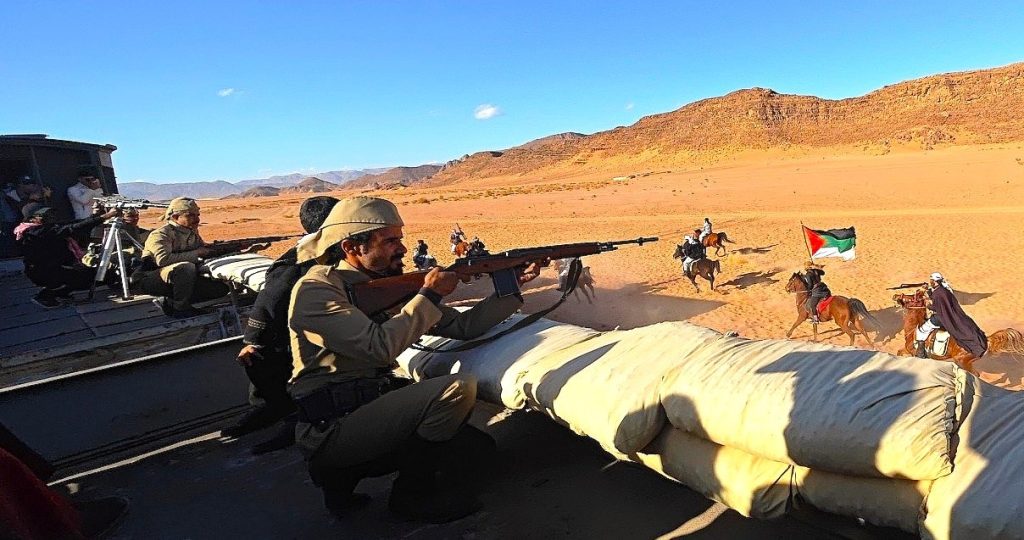
.
Wadi Rum Village
The Wadi Rum Village, set between Jebel Rum and Jebel Um Ashreen, is the only settlement within the protected area. It is home to around 2,000 mostly Bedouin residents and comprises a mix of traditional goat-hair tents and modern concrete but simple homes, reflecting the blend of heritage and contemporary living.
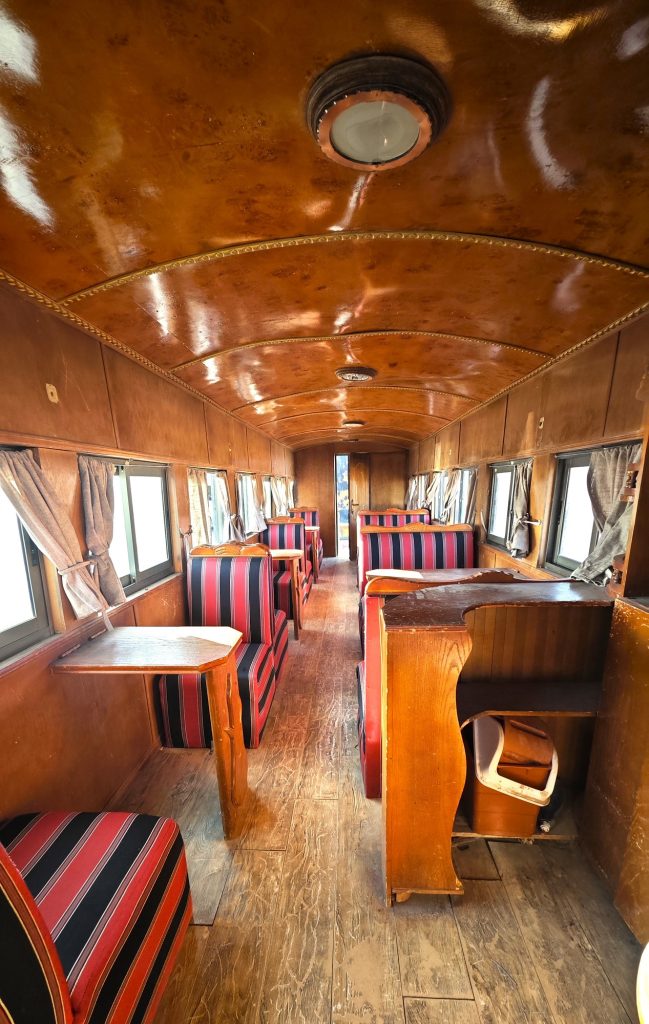
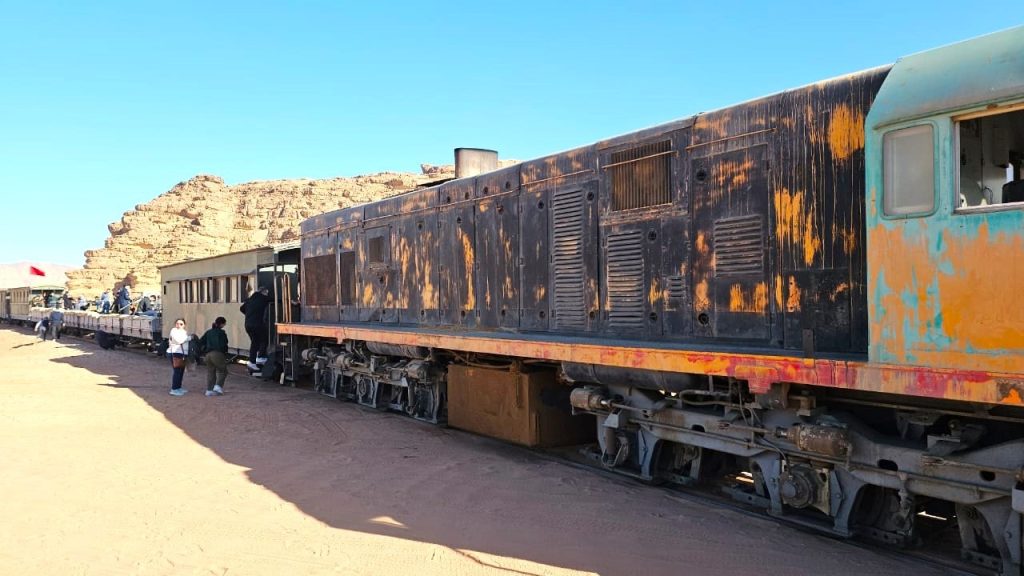
While the village lacks certain amenities like ATMs and extensive public facilities, it remains a hub for desert excursions. Local Bedouin guides offer a range of experiences, from camel treks to jeep tours, allowing visitors to explore the vast desert landscapes. The village also serves as the starting point for the Wadi Rum Trail, a route that traverses some of the region’s most breathtaking terrains.
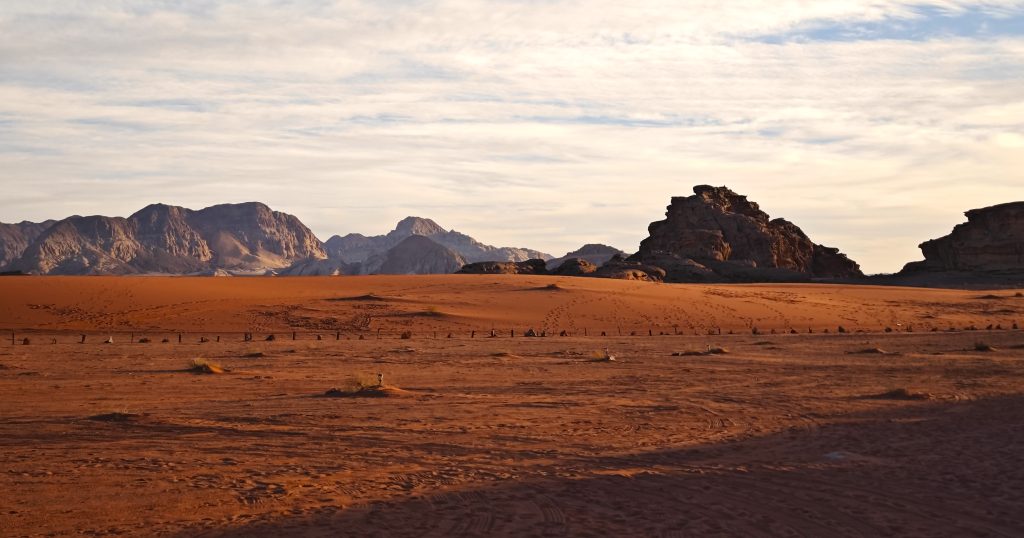
Journey into the Rum
Our journey deep into the Wadi Rum Desert started- and what a visually stunning treat it was for us! The drive began deceptively quietly. As the jeep pulled away from the paved road, the world transformed. The air becomes drier, redder and stiller. From the edge of the protected area started endless sands – crimson sands stretched to the horizon, broken only by towering sandstone mountains that looked carved by giants.
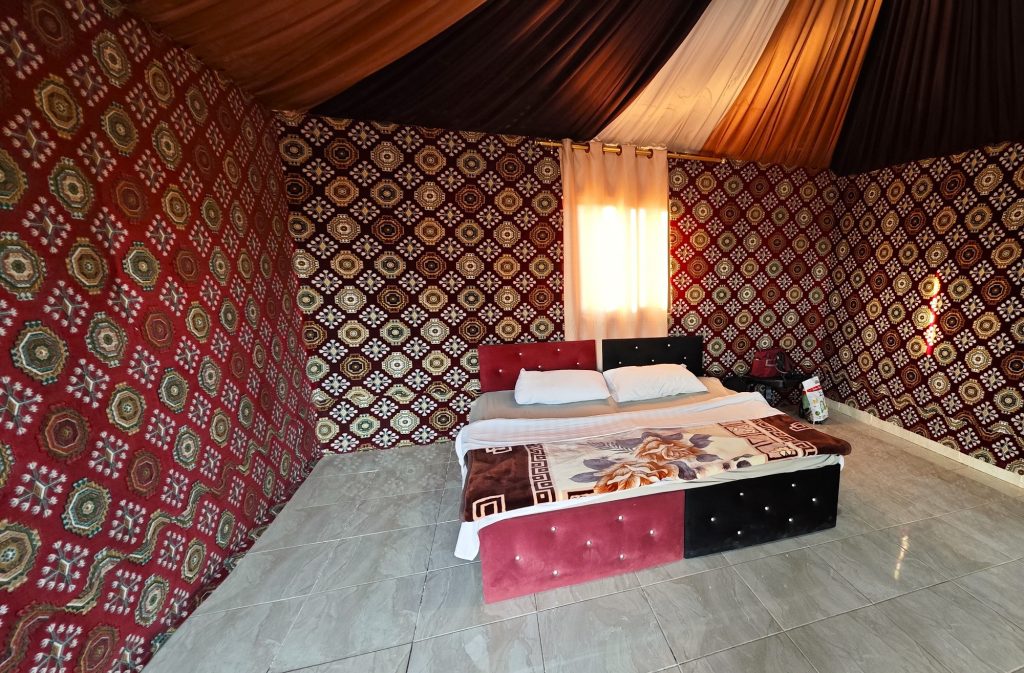
When our phone signals disappeared we realized that we were officially in another realm. It was almost time for the sun to set and we were in a hurry to reach our camp from where we could witness a desert sunset. Though it was extremely cold and cloudy, and the weather not really supportive, we hoped to get at least a glimpse of something. As it turned out time was in our favor but the weather not so much. We reached the camp with enough time to freshen up and have a cup of tea .
Types of accommodation
There are three main types of stays at Wadi Rum.
There are the traditional Bedouin camps -basic but cozy. These camps offer private or shared tents, shared bathrooms, and authentic meals cooked over fire. The real joy is the community feel — singing around the fire, storytelling, and eating under the stars. Our camp was one such reflecting the genuine Bedouin way of life.
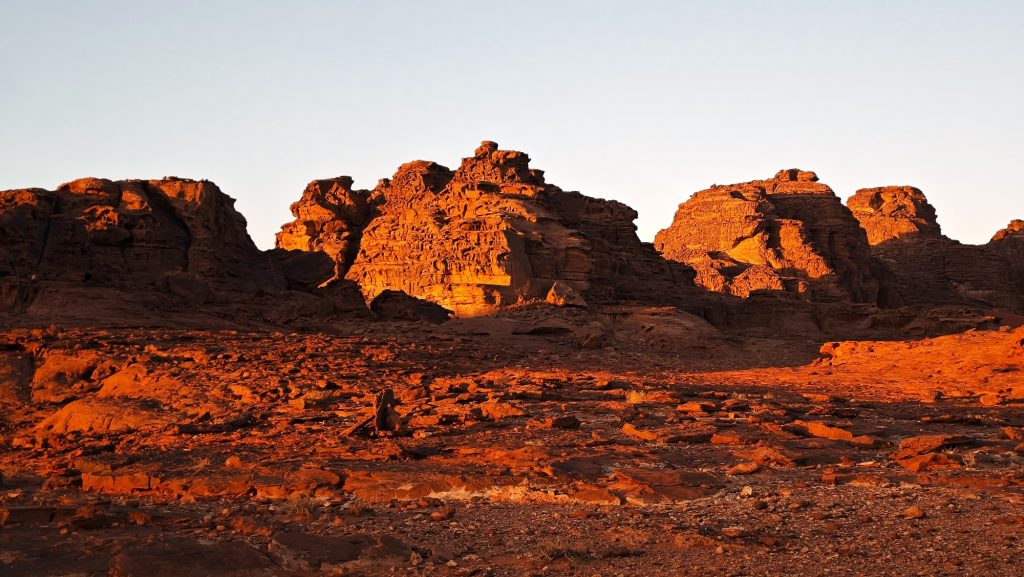
There are also the luxury desert camps. These offer hotel-level comfort: proper beds, private bathrooms, electricity, gourmet food and specially the bubble domes.
But we had opted for one of the more authentic camps to get a feel of the Bedouin’s way of life.
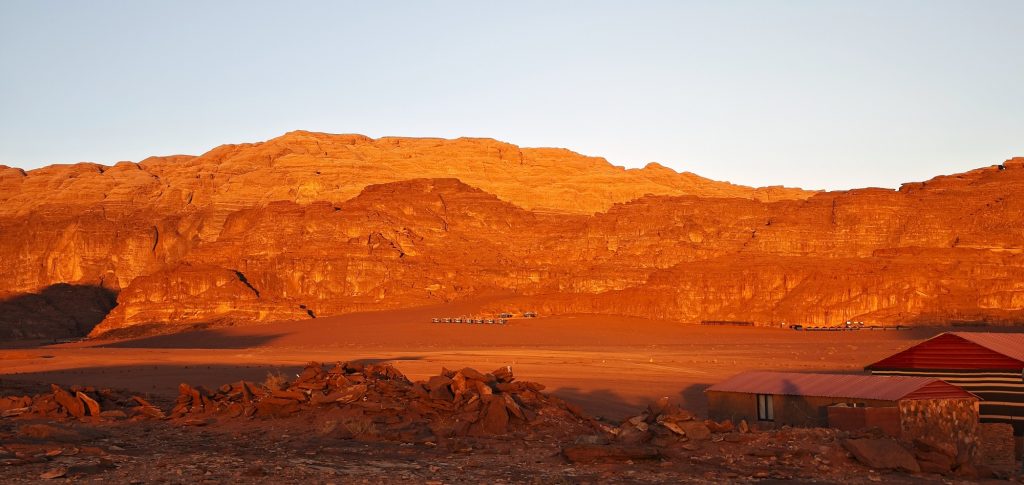
Then there’s the wild camping experience. If you want to feel like the last person on Earth some guides offer ‘wild camps’, where you sleep on a mattress in a remote desert alcove with nothing but stars for a ceiling. That of course would have been a little too much in that extremely cold weather. It’s safe, peaceful, and unforgettable — but not for those who need Wi-Fi and showers.
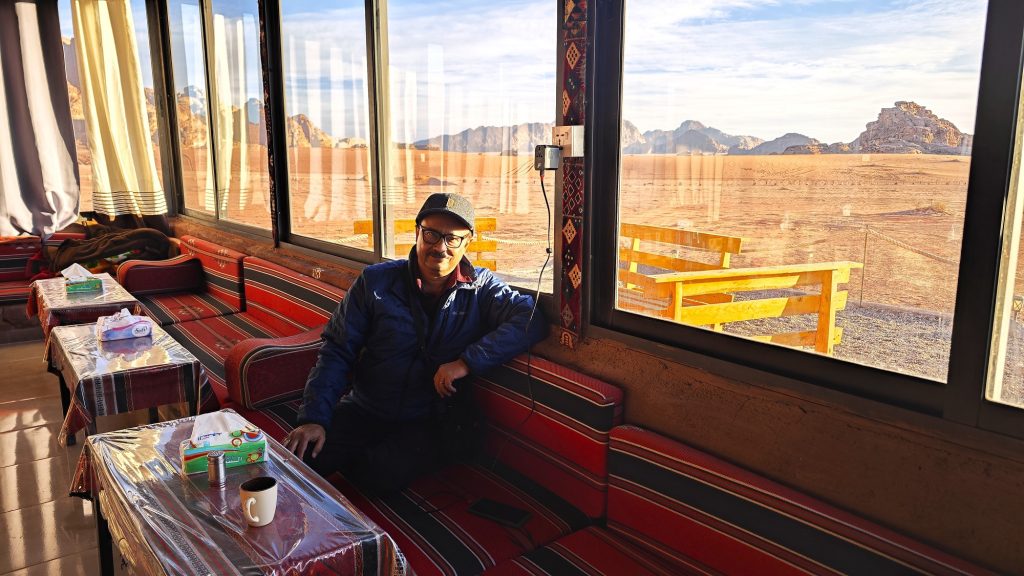
Bedouin tea
After freshening up we went to the huge dining hall where we were served hot Jordanian tea with an assortment of locally made biscuits in typical Bedouin style – sitting and relaxing on the sandy floor divided into sections with the red and black striped rugs, cushions, and low seating- spread all over, creating a warm, welcoming space for family and guests.
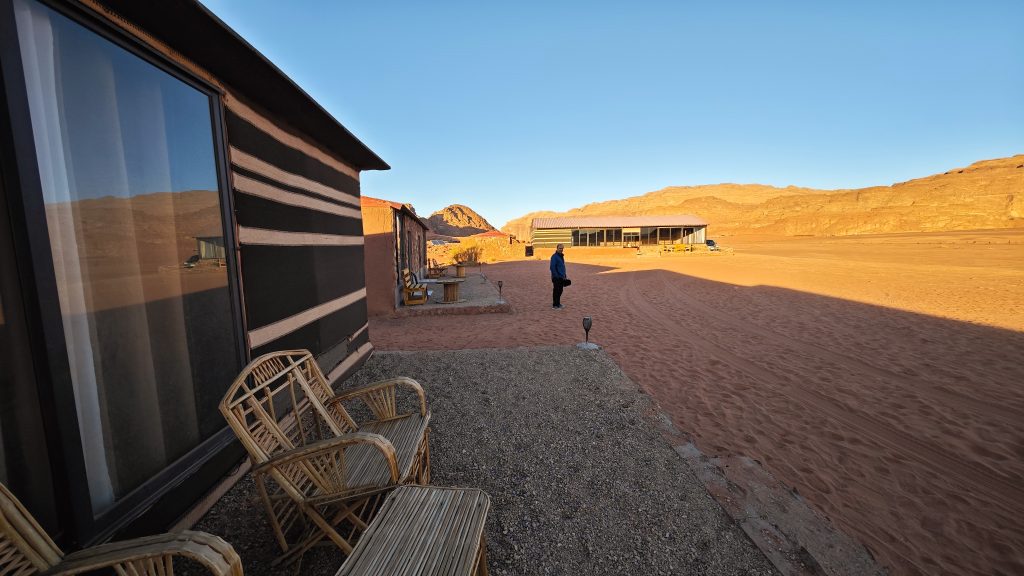
We had got the opportunity to live the Bedouin life, albeit for a few hours. This was thanks to the real soul of Wadi Rum -the Zalabieh Bedouins-our hosts- who have lived here for generations and are stewards of the land. Many families have adapted to tourism, running jeep tours, camel treks, and desert camps. But their connection to the land remains deep.
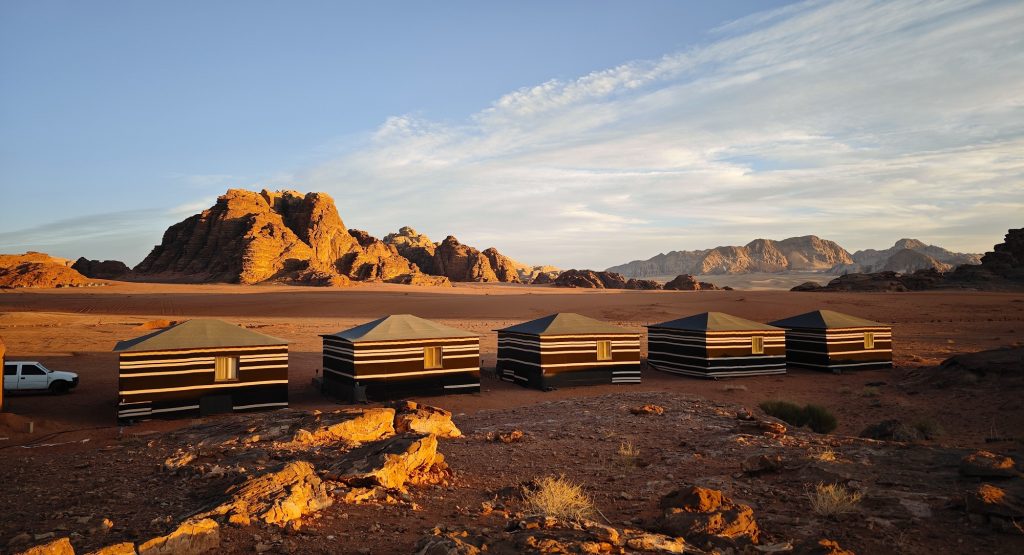
Tea preparation is a central part of Bedouin hospitality. Over a small open fire, a metal kettle simmered with a mix of water, black tea, sugar, and a handful of fresh herbs. The tea was strong, sweet, and deeply aromatic.
A Desert sunset
After being invigorated we went out to view the sunset .Our camp had a wonderful viewpoint just at the back for sunset viewing. We wandered around the silent, peaceful area taking in the vast desert landscape as well as the slowly setting sun. The sky was cloudy making the sun weak but it was more than enough for our senses.
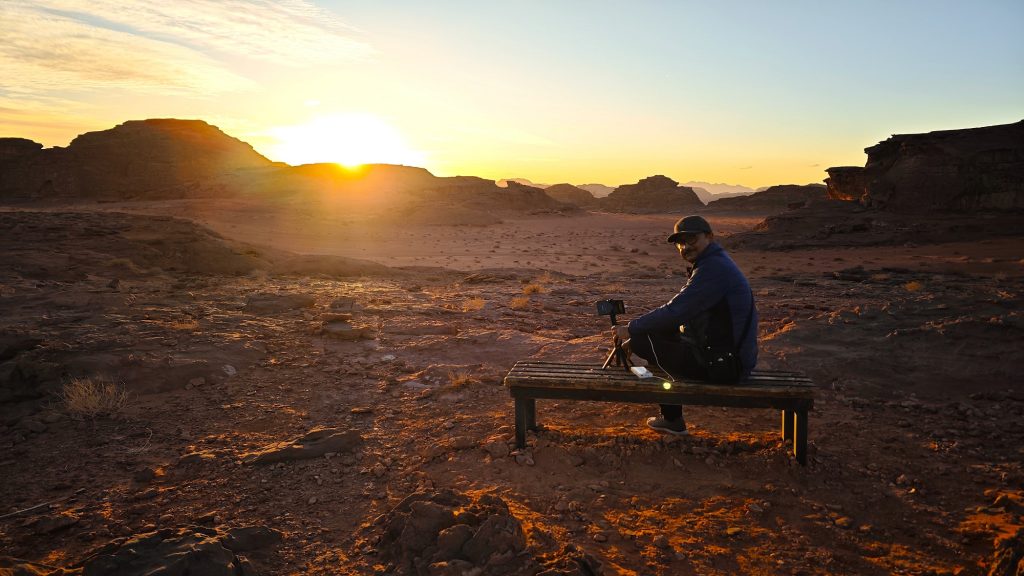
The name Wadi Rum comes from the Arabic ‘wadi’ (valley) and likely ‘Iram’, an ancient tribe. But locals simply call it ‘The Valley of the Moon’, and that’s exactly how it felt sitting there at dusk. The red sand glowed like embers and the sky turned the color of fire and the Rum’s silence was profound. We just sat and sat witnessing a mesmerizing sunset across the horizon with not a soul in sight. And we sat until we couldn’t see ourselves in the dark, taking in the tranquility and the emptiness of the place -a place that felt both impossibly old and impossibly otherworldly.
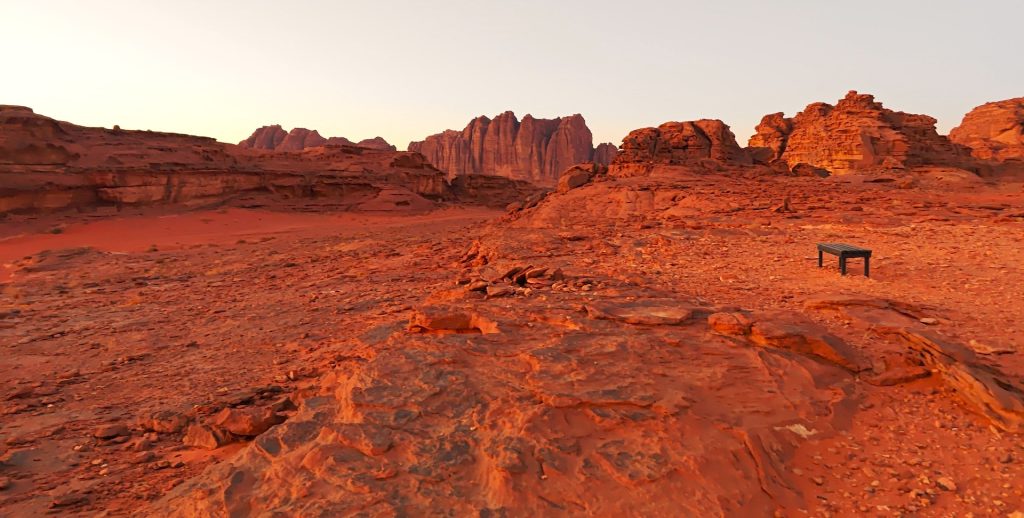
A Bedouin dinner
Every moment turned out to be unique. The next one was the Bedouin dinner. In Wadi Rum, meals are communal and deeply rooted in Bedouin tradition and there signature dish is the Zarb. Zarb is the desert’s version of BBQ — meat and vegetables cooked in a sand oven underground. The result? Smoky, tender, melting-off-the-bone perfection. I had expected to have a Zarb but luck didn’t favour us again. The camp had designated days for that.
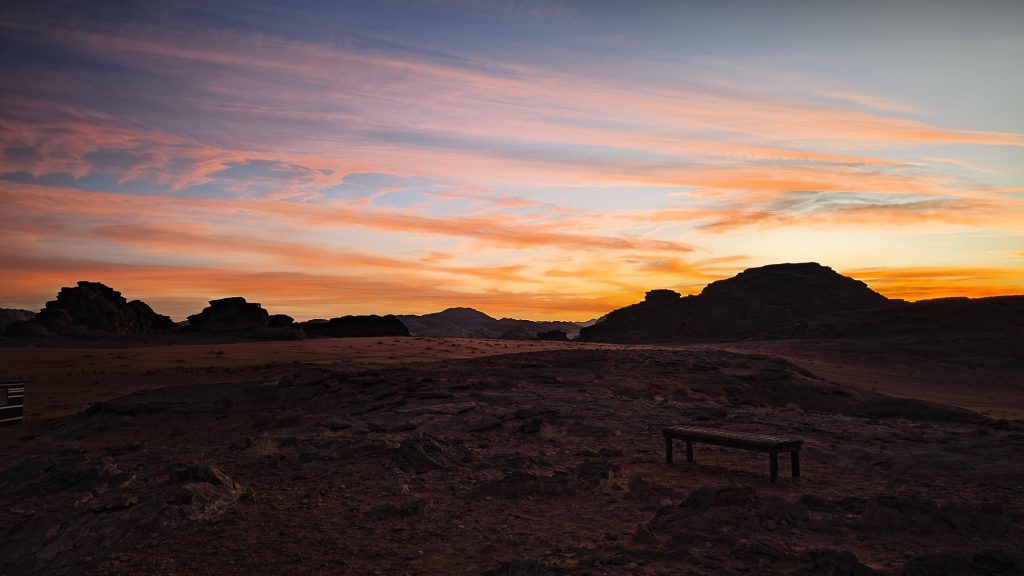
Instead we had to settle for Maqloubeh – a dish of spiced rice, meat, and veggies flipped upside down. This is also a very common dish amongst Bedouins and also turned out to be extremely tasty. The camp chef gave us a lively demonstration of how to flip and serve it.
But the dinner counter was also spread out with other staples like lentil soup, labneh, olives, flatbread , a variety of salads and spreads, and of course sweet Bedouin tea.
It was a simple, smoky, and satisfying meal which we ate together, sitting on the rugs- being our most natural selves.
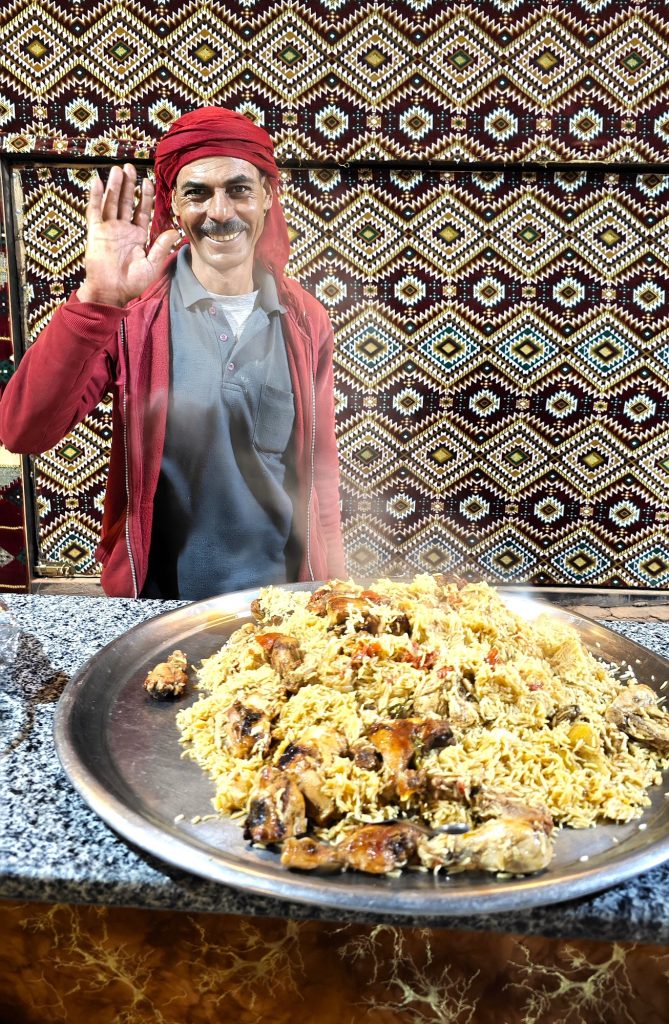
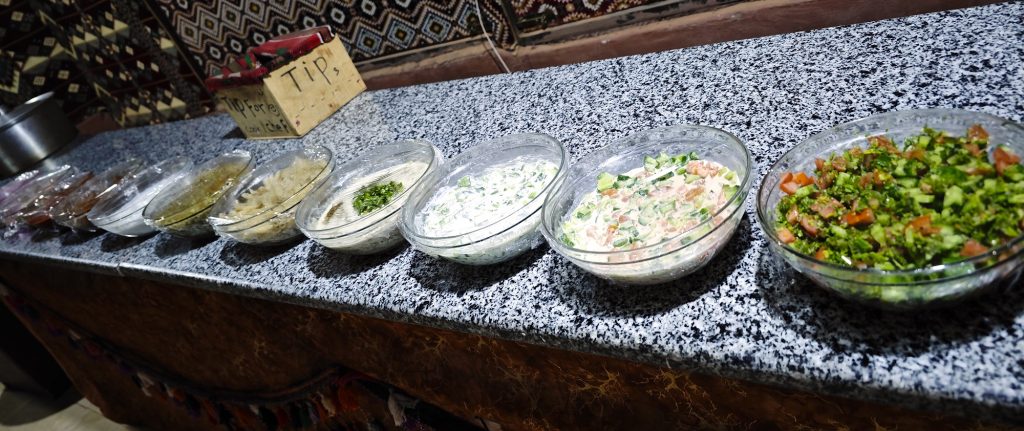
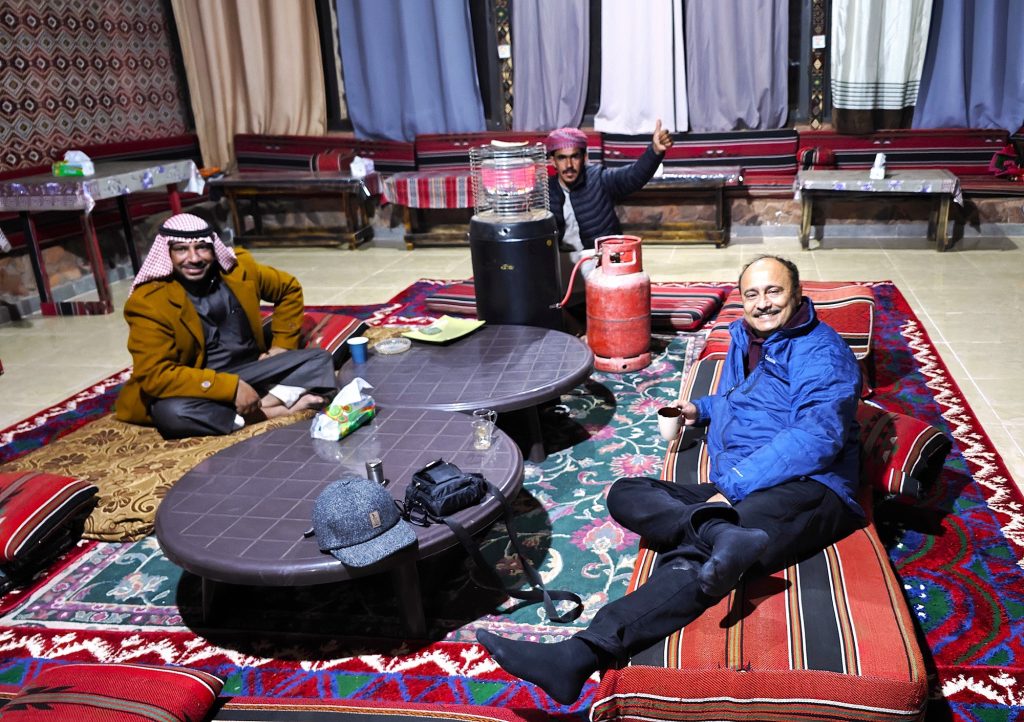
Star gazing
But dinner was not the end of our day. The path from the dining hall to our tent ( yes….I forgot to mention -we were staying in a huge tent! ) was lit up with solar lamps lending a ghostly quality to the endless darkness. But we gazed upward at the sky and a totally different story was unfolding there. There was no light pollution, the night was clear and Wadi Rum’s sky exploded with a million stars, a billion planets, and countless meteor trails all shining like jewels. It was like being inside a planetarium but without the roof.
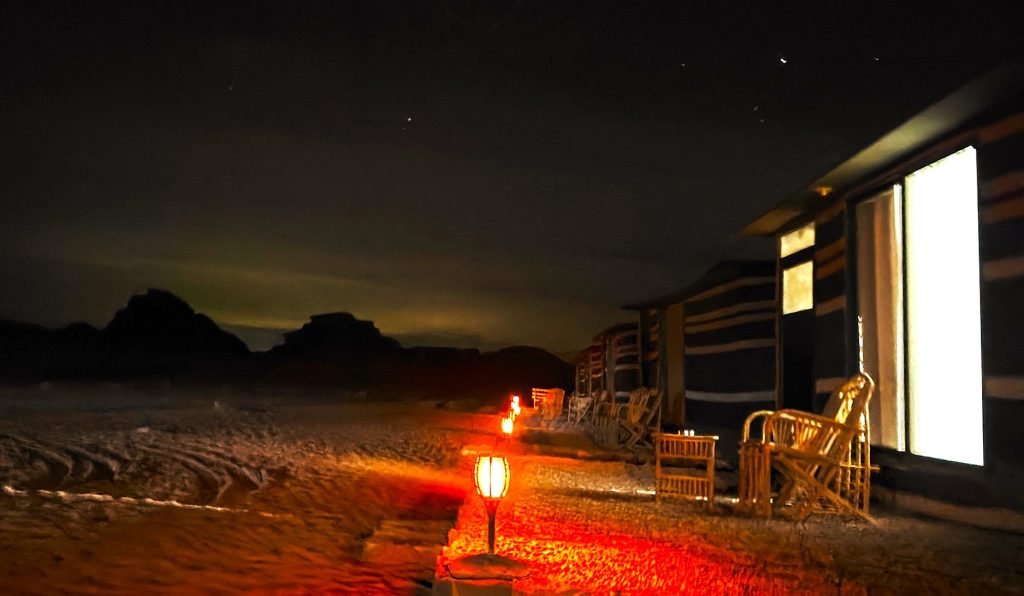
I had read somewhere that some camps even offered astronomy tours with telescopes and guided stargazing sessions. We weren’t offered any such thing but who needed a scientific explanation for this magical night sky with its sweeping dome of stars including Orion, Scorpio, the Great Bear, and the Milky Way revealing itself in full splendor—like a thick river of stars streaking across the sky. It was like the universe stretched on forever with the silence of the desert intensifying the moment.

Deep into the night
As I lay wrapped in thick blankets beneath the canvas roof, the desert’s silence wrapped around me like a second skin. The cold outside, the lack of luxuries like a room heater or an air conditioner, only made the warmth inside more earned. Staring at the stars through the window with sleep laden eyes , I felt something I hadn’t in a long time—complete peace. And it was with this feeling in mind that we prayed for a promising next day !


